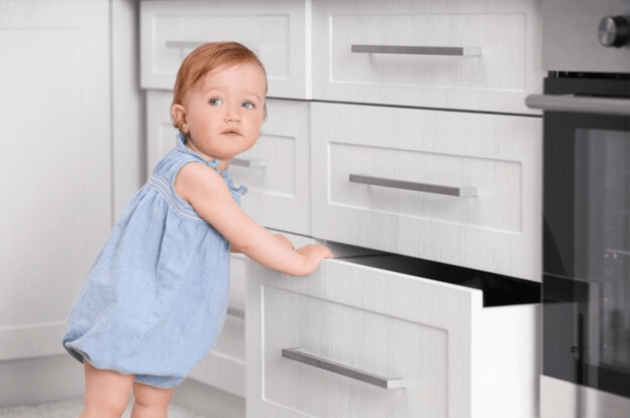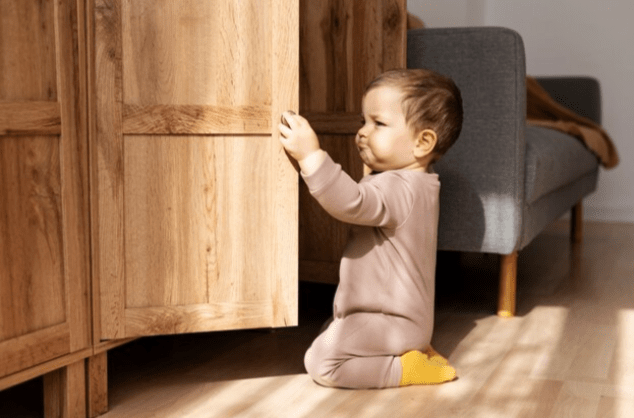Find the best installation advice and childproofing cabinet locks to ensure your house is a secure haven for young, curious minds.
Knowing Why Childproofing Cabinets Are Necessary
A child’s first playground, their home, is a place of exploration and education. Since there is always room for adventure in this place, parents and other caretakers must ensure everything is safe. Although sometimes disregarded, bathrooms and kitchens may be fascinating places for young adventurers to discover hidden hazards such as sharp objects, medicines, and cleaning supplies. Even seemingly innocuous things might pose a choking hazard in tiny hands. Childproofing cabinets are essential to creating a secure environment where kids can develop and play, not only a preventive precaution. By safeguarding these spaces, parents may reduce hazards, stop mishaps, and foster a safe environment where kids can play and learn without fear. To maintain the home as a haven of safety and happiness for the youngest family members, parents and other caregivers must make essential decisions on childproofing. After all, they are the guardians of their child’s world.
Cabinet Lock Types

Various cabinet locks are made to keep kids out while facilitating adult access. The most popular ones are as follows:
Magnetic Locks: With a magnetic key system for entry, magnetic locks within cabinets provide strong security. They maintain the beauty of your cabinets without being visible from the outside, guaranteeing safety. This understated yet practical solution blends security and design to keep harmful things out of children’s reach and preserve the appearance of your home and your child’s well-being.
Adhesive Mounts: Adhesive locks adhere straight to cabinet doors, making installation simple and tool-free. Even if they’re easy to use and convenient, alternative solutions could be more sturdy than they are, and taking them out could scratch the cabinet’s surface. These locks offer an easy remedy but must be handled carefully for long-term use and to maintain the cabinetry’s appearance.
Cord locks: Perfect for cabinets with knobs or handles because they securely fasten two handles together. They provide a versatile solution and are easy to install and uninstall. Verifying their compatibility before using them is essential, as they might only work with some cabinets.
Spring-Release Locks: These locks are installed within cabinets and use a spring mechanism to shut the door. The strength and skill of an adult are needed to press down and release the spring on these child-resistant locks to access the contents. Even though they are difficult for kids to open, they offer a dependable safety precaution, keeping potentially harmful objects out of young hands and guaranteeing a safer setting for curious young explorers.
Sliding locks: Sliding locks are a simple way to secure cabinet handles in place and keep them from opening. Intended for adult ease of use, they are simple to remove and modify, yet they pose a difficult barrier for kids. They are a sensible option for protecting inquisitive young children because of this balance between accessibility and security.
How to Install
Selecting the Proper Lock: Consider your needs and your cabinets’ style when purchasing. Make sure the lock complements the cabinet’s design and your proficiency level in using it.
Read directions: Carefully read the manufacturer’s directions before installing any locks. This guarantees that you know how to install and use it properly.
Clean the Area: To guarantee that the glue sticks correctly using an adhesive lock, ensure the cabinet surface is dry and clean before installation.
Measure and Mark: You should measure and mark the location of several locks. To make sure the lock works properly, be exact.
Install: Adhere to the lock’s specified installation instructions. This could be fastening components using screws, applying adhesive pads, or assembly components.
Try: To ensure the lock is safe and functions as intended, try it multiple times after installation.
Tips for Upkeep and Safety
Frequent Checks: Make sure the locks are still secure and operating correctly by doing periodic checks. The adhesive may deteriorate with time, causing parts to fall loose.
Teach and Supervise: Instruct older kids on the value of safety and the reasons behind not attempting to access locked cabinets. Children should always be supervised, especially in potentially dangerous areas.
Store Keys Safely: If your locks require keys, store them somewhere children can’t reach them—a secure, conspicuous location.
Be Uniform: Make sure every cabinet that poses a risk is locked. Inconsistency can cause mishaps if a kid finds an unlocked cabinet.
Extra Things to Think About

Beyond Cabinets Childproofing: Consider additional spots in the house, including doors, electrical outlets, furniture corners, and staircases, that might require childproofing.
Become Informed: Keep up with product recalls and safety announcements about childproofing items.
Expert Assistance: If you need help installing locks appropriately, consider hiring an expert or consulting kid safety specialists.
Establishing a Safe Exploration Area: Although limiting access to potentially harmful objects is critical, ensure kids have a secure area to play and explore. This fosters their innate curiosity and growth securely.
Frequent Updates: Your child’s skills and interests will evolve as they get older. Make sure your childproofing techniques are still acceptable and working by regularly reevaluating them.
In Conclusion
Building a safe and secure environment for young children requires childproofing cabinets. This proactive strategy tackles the hidden risks within easily accessible cabinets, which frequently contain hazardous materials and items. Recognizing the need for this safety precaution is the first step in protecting your child’s surroundings. Many locks and latches are available on the market, each made to accommodate various cabinet styles and parental preferences. Making the appropriate choice is essential, but maintaining its continued efficacy requires correct installation and routine maintenance. Recall that children’s skills and curiosities change as they age, making childproofing a dynamic and flexible process. Maintaining a protected environment for your child requires being aware of the most recent advancements in safety and keeping a close eye on their growth. Parents and other caregivers can establish a home where children can safely satisfy their natural curiosity while fostering discovery and development by committing to this ongoing process.
We hope you found this information helpful in creating a safer environment for your family. At GuardWell Safety, we understand that every home is unique, as are your child-proofing needs. That’s why we offer a Free Child-Proofing Consultation tailored to your requirements. Let our experts help you identify potential hazards and provide personalized solutions to make your home a secure haven for your little ones. Book your free consultation today and take the first step towards peace of mind.






